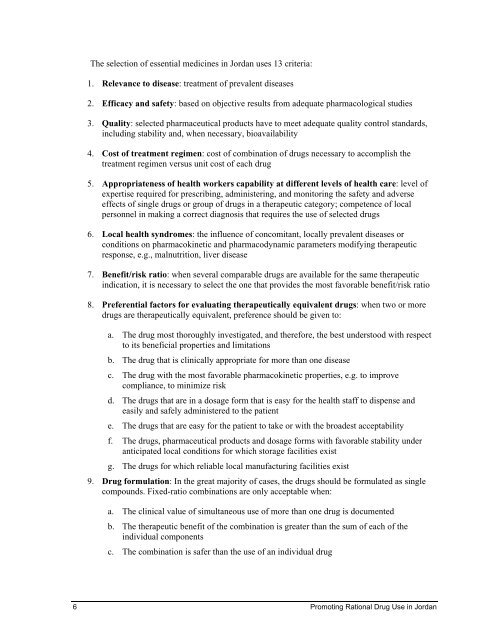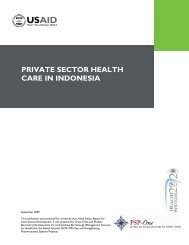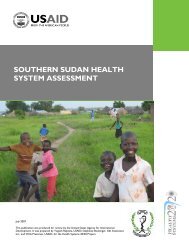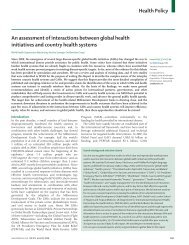Promoting Rational Drug Use in Jordan - PHRplus
Promoting Rational Drug Use in Jordan - PHRplus
Promoting Rational Drug Use in Jordan - PHRplus
You also want an ePaper? Increase the reach of your titles
YUMPU automatically turns print PDFs into web optimized ePapers that Google loves.
The selection of essential medic<strong>in</strong>es <strong>in</strong> <strong>Jordan</strong> uses 13 criteria:<br />
1. Relevance to disease: treatment of prevalent diseases<br />
2. Efficacy and safety: based on objective results from adequate pharmacological studies<br />
3. Quality: selected pharmaceutical products have to meet adequate quality control standards,<br />
<strong>in</strong>clud<strong>in</strong>g stability and, when necessary, bioavailability<br />
4. Cost of treatment regimen: cost of comb<strong>in</strong>ation of drugs necessary to accomplish the<br />
treatment regimen versus unit cost of each drug<br />
5. Appropriateness of health workers capability at different levels of health care: level of<br />
expertise required for prescrib<strong>in</strong>g, adm<strong>in</strong>ister<strong>in</strong>g, and monitor<strong>in</strong>g the safety and adverse<br />
effects of s<strong>in</strong>gle drugs or group of drugs <strong>in</strong> a therapeutic category; competence of local<br />
personnel <strong>in</strong> mak<strong>in</strong>g a correct diagnosis that requires the use of selected drugs<br />
6. Local health syndromes: the <strong>in</strong>fluence of concomitant, locally prevalent diseases or<br />
conditions on pharmacok<strong>in</strong>etic and pharmacodynamic parameters modify<strong>in</strong>g therapeutic<br />
response, e.g., malnutrition, liver disease<br />
7. Benefit/risk ratio: when several comparable drugs are available for the same therapeutic<br />
<strong>in</strong>dication, it is necessary to select the one that provides the most favorable benefit/risk ratio<br />
8. Preferential factors for evaluat<strong>in</strong>g therapeutically equivalent drugs: when two or more<br />
drugs are therapeutically equivalent, preference should be given to:<br />
a. The drug most thoroughly <strong>in</strong>vestigated, and therefore, the best understood with respect<br />
to its beneficial properties and limitations<br />
b. The drug that is cl<strong>in</strong>ically appropriate for more than one disease<br />
c. The drug with the most favorable pharmacok<strong>in</strong>etic properties, e.g. to improve<br />
compliance, to m<strong>in</strong>imize risk<br />
d. The drugs that are <strong>in</strong> a dosage form that is easy for the health staff to dispense and<br />
easily and safely adm<strong>in</strong>istered to the patient<br />
e. The drugs that are easy for the patient to take or with the broadest acceptability<br />
f. The drugs, pharmaceutical products and dosage forms with favorable stability under<br />
anticipated local conditions for which storage facilities exist<br />
g. The drugs for which reliable local manufactur<strong>in</strong>g facilities exist<br />
9. <strong>Drug</strong> formulation: In the great majority of cases, the drugs should be formulated as s<strong>in</strong>gle<br />
compounds. Fixed-ratio comb<strong>in</strong>ations are only acceptable when:<br />
a. The cl<strong>in</strong>ical value of simultaneous use of more than one drug is documented<br />
b. The therapeutic benefit of the comb<strong>in</strong>ation is greater than the sum of each of the<br />
<strong>in</strong>dividual components<br />
c. The comb<strong>in</strong>ation is safer than the use of an <strong>in</strong>dividual drug<br />
6 <strong>Promot<strong>in</strong>g</strong> <strong>Rational</strong> <strong>Drug</strong> <strong>Use</strong> <strong>in</strong> <strong>Jordan</strong>
















